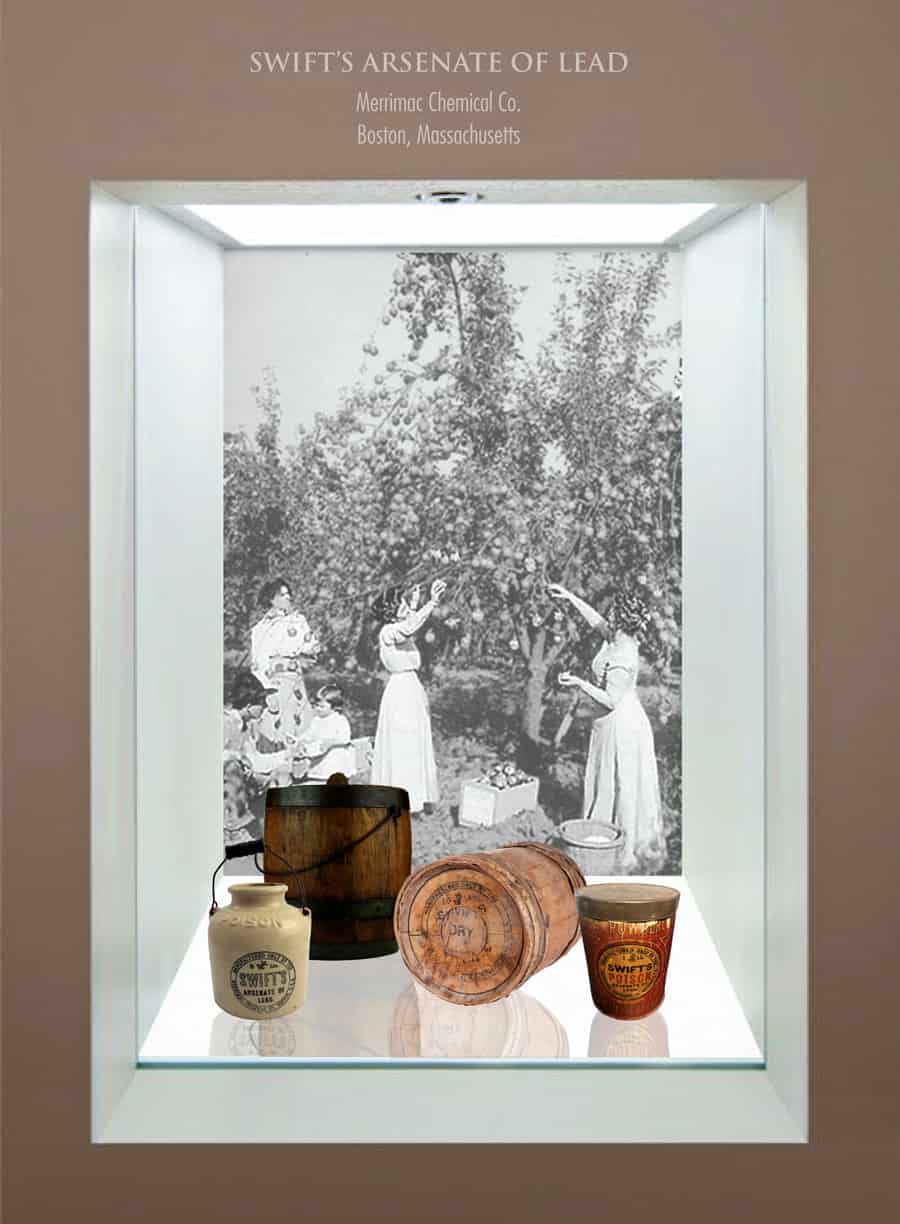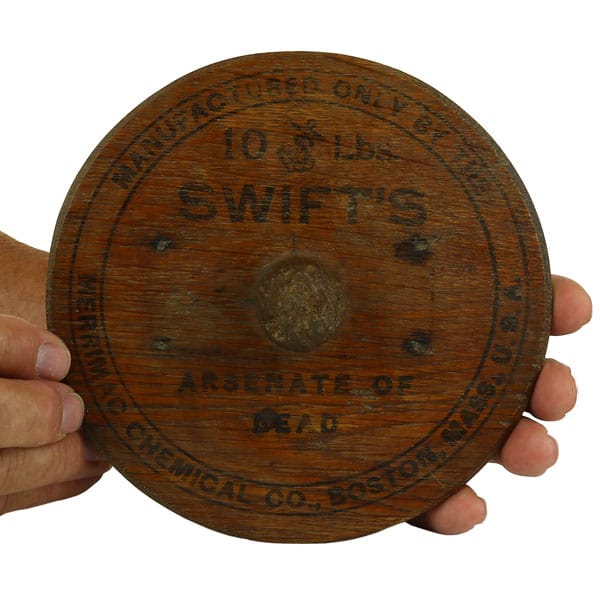Swift’s Arsenate of Lead
Swift’s Arsenate 0f Lead
Poison
Merrimac Chemical Co., Boston, Mass. U.S.A.
William H. Swift Company
Wooden Powder Keg
Provenance: Louis Fairfield Collection

Here is an extraordinary, possibly unique in this condition, wooden 10-lb barrel-form keg containing “Swift’s Arsenate of Lead.” The sides are stamped ‘POISON’ twice though the copy is upside down. The top is stamped and reads, “Manufactured only by the Merrimac Chemical Co., Boston, Mass. U.S.A.” The size is approximately 11 inches tall by 8 inches wide. There is a knob on the lid to assist in opening and closing. Three attached metal bands encircle the barrel to hold the wood slats together. There is a metal bucket handle. The condition is excellent.
Arsenate of Lead was first used as an insecticide when it was introduced in 1898 against the gypsy moth in Massachusetts. It adhered better to the surface of the plants, further enhancing and prolonging its insecticidal effect. Because of this, it was used mainly on apples but also on other fruit trees, garden crops, turfgrasses, and against mosquitoes. In the early 20th century, it was the most popular pesticide.

In the year 1929, almost 30 million pounds of lead arsenate and calcium arsenate were spread across this country’s fields and orchards. During a 1935 weekly radio program sponsored by the U.S. Food and Drug Administration, the host suggested that the old-time school rhyme “A is for Apple” be changed as follows: “A is for Arsenate – Lead if you please – Protector of Apples – Against Archenemies.”

Merrimac Chemical Company – Between 1853 and 1933
Woburn Chemical Works (the predecessor to Merrimac Chemical Company), Merrimac Chemical Company, and Merrimac Division of Monsanto (the company that bought Merrimac Chemical Company) manufactured sulfuric acid, arsenic-based insecticides, acetic acid, and chemicals for the textile, leather tanning, and paper manufacturing industries (Tarr 1987 ).
The companies used the lead chamber method to produce sulfuric acid. In the late 19th century, pyrite ore was used as the source of sulfur. In the process, pyrite (iron disulfide) was burned on-site, and the residual slag was treated to recover copper. The major substances used in the manufacturing processes were lead, arsenic, sulfur, pyrite ore, and dry colors. Pyrite ore also contains several heavy metals, and the dry colors likely contained lead, mercury, and chromium.
Wastes on the manufacturing site included pyrite cinder, calcium sulfate, iron oxide, lead sulfate, calcium carbonate, bauxite, waste mud, and other byproducts.
In 1899, Merrimac Chemical purchased the William H. Swift Company and became the largest producer of arsenic-based insecticides in the United States.
In 1915, the Merrimac Chemical Company started the New England Manufacturing Company to manufacture organic chemicals such as phenol, benzene, trinitrotoluol (TNT), trinitrophenol as well as toluene. This company produced World War I munitions and the plant was adjacent to the old Merrimac Chemical facility. In 1929, Merrimac Chemical Company was acquired by Monsanto Chemical Works of St. Louis (Tarr, 1987). In 1934, Monsanto closed its Woburn facility.

Primary Image: Swift’s Arsenate of Lead imaged on location by the FOHBC Virtual Museum midwest studio led by Alan DeMaison.
Support: The Woburn Toxic Trial, Chemical Industries in Woburn. 1986 Federal trial.
Support: A is for Arsenic (pesticides, if you please), Deborah Blum, Wired, June 19, 2012
Support Image: eBay Description – Antique Stoneware jar marked Swift’s Arsenate of Lead Merrimac Chemical Co. Boston. Embossed Poison with a bale handle. No lid. Jar is empty and completely clean . Age – ca 1900. Size – 6 ½” x 5 ¾” in dia.
Support: Antique Poison Bottle Collectors Association
Join the FOHBC: The Virtual Museum is a project of the Federation of Historical Bottle Collectors (FOHBC). To become a member.














